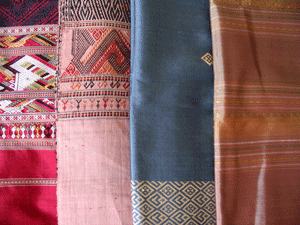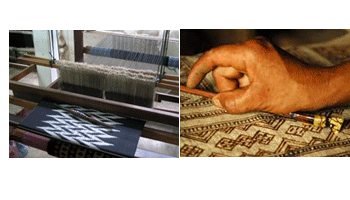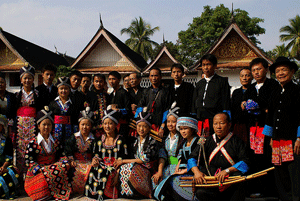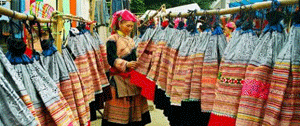
Many motifs used in Lao textiles are derived from the textiles of the Lao-Tai ethnic groups. The Lao-Tai are generally shamanic people with a strong belief in the afterworld. Nowadays, Buddhism is becoming more popular and links to animism or shamanism are looked upon as old-fashioned, thus Buddhist beliefs are increasingly used to interpret icons.
Usually textiles depict stories of ancestors spirits traveling to the afterworld, stories of Nagas and their influences on life around them, Siho – the half lion half elephant figure and motifs inspired by nature and daily life. These motifs appear in various forms of the many different sub ethnic groups of the Lao-Tai and using a number of techniques.
Other weavers in Laos are Hmong, and a few Khamu groups. These groups don’t weave the densely patterned techniques that the Lao-Tai weave. Hmong weave hemp and cotton and dye fabric with indigo. This is the base cloth for their intricate embroidery. Hmong also practice batik. The Khamu weave cotton for clothing.
 Ikat Skirt (Sin in Lao language) :
Ikat Skirt (Sin in Lao language) :
These tubular fabrics are all Pa Sin or skirt lengths. They are a combination of silk and cotton depending on their purpose; silk for ceremonies and cotton for everyday use. Pa Sin consists of three parts the waistband hua sin, a main body purn sin and a border tiin sin.
Certain details communicate things about the wearer such as marital status, social class and aptitude as a weaver. For example in Sam Nua a red or blue waistband means the wearer is unmarried.
Ikat skirts are rare as not every weaver is proficient in this art. There are many different ikats, according to the speciality of provinces of the country.
Silk is a wonderful material. Warm or cool, it adapts to the outside temperature.
Ecologically correct – no pesticide used in the production of silk thread – anti- allergenic and hand made, the silk from Laos is of great quality.

Batik Hmong :
Batik is a resist dye technique created by wax drawn motifs. The technique has been practiced for over a thousand years from South America to Africa; Indonesia is accredited with its origin, due to Dutch trading. Traditionally, Hmong people use hemp as a base fabric. The batik design is used for clothing such as skirts and household items such as blankets.






